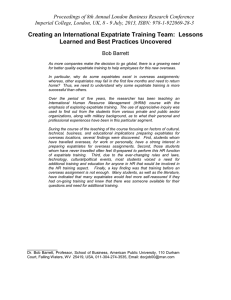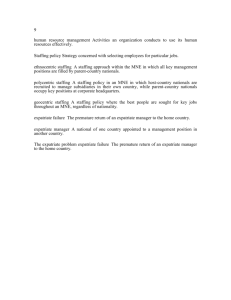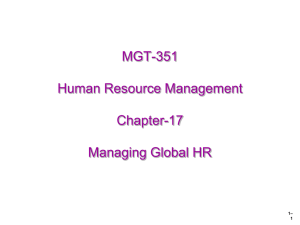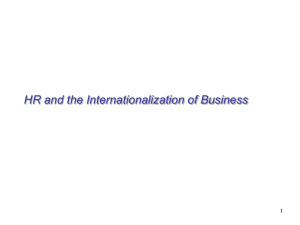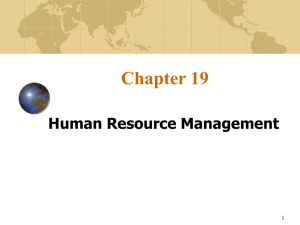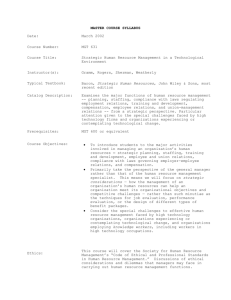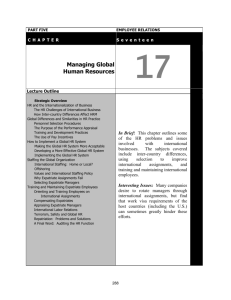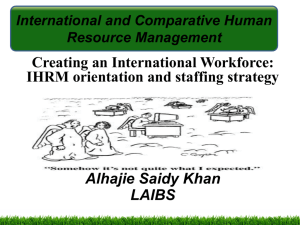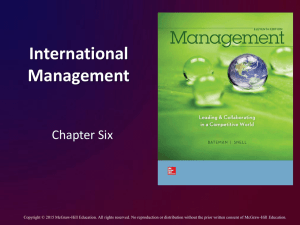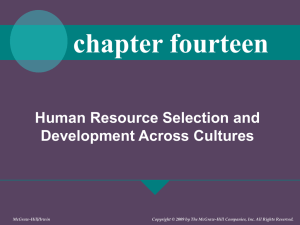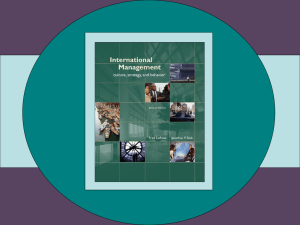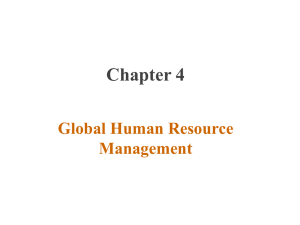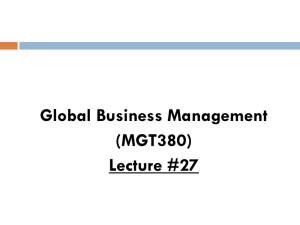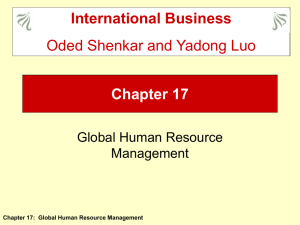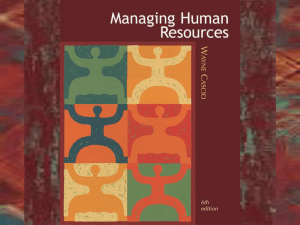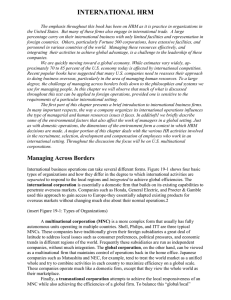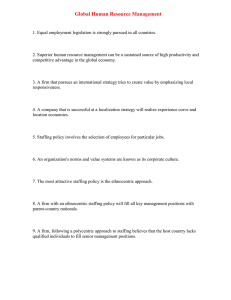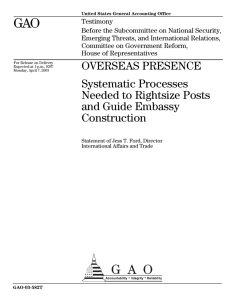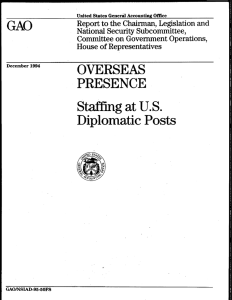Human Resource Management
advertisement
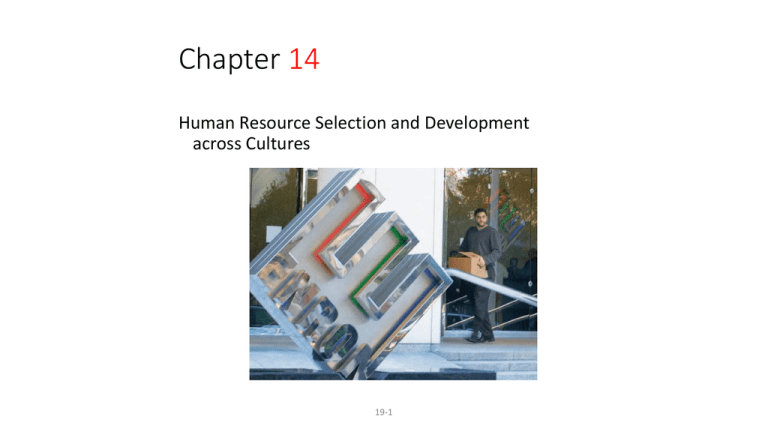
Chapter 14 Human Resource Selection and Development across Cultures 19-1 Objectives • Describe the nature of human resource management in international business • Detail how firms recruit and select managers for international assignments • Explain how international businesses train and develop expatriate managers • Describe labor relations in international business 19-2 Objectives (continued) • Discuss how international firms conduct performance appraisals and determine compensation for their expatriate managers • Analyze retention and turnover issues in international business • Explain basic human resource issues involving nonmanagerial employees 19-3 Human Resource Management Human Resource Management is the set of activities directed at attracting, developing, and maintaining the effective workforce necessary to achieve a firm’s objectives. 19-4 Figure 19.1 The International Human Resource Management Process HRM’s Strategic Content Recruitment and Selection Training and Development Performance Appraisal Compensation and Benefits Labor Relations Contribution to Organizational Effectiveness 19-5 International Staffing Needs Managerial/Executive Employees Nonmanagerial Employees 19-6 Scope of Internationalization Export Department International Division Global Organization 19-7 Expertise Needs in Global Organizations Product line Functional skills Individual country markets Global strategy 19-8 Centralization versus Decentralization of Control • Centralized firms • Favor home country managers • Most common amongst international division form • Decentralized firms • Favor host country managers • Most common amongst multidomestic firms 19-9 Staffing Philosophy Parent Country Nationals (PCNs) Third Country Nationals (TCNs) Host Country Nationals (HCNs) 19-10 Strategies for Staffing • Ethnocentric staffing model • Polycentric staffing model • Geocentric staffing model 19-11 Figure 19.2 Necessary Skills and Abilities for International Managers Skills and Abilities Necessary to Do the Job Skills and Abilities Necessary to Work in a Foreign Location •Technical •Functional •Managerial •Adaptability •Location-specific skills •Personal characteristics Improved Chances of Succeeding in an International Job Assignment 19-12 Recruitment of Managers Younger Managers Experienced Managers 19-13 Selecting expatriates is an important element in international HRM. 19-14 Selection of Managers Managerial competence Appropriate training Adaptability to new situations 19-15 Table 19.1 Questions from AT&T’s Questionnaire for Screening Overseas Transferees 1 • Would your spouse be interrupting a career to accompany you on an international assignment? If so, how do you think this will affect your spouse and your relationship with each other? • Do you enjoy the challenge of making your own way in new situations? • Securing a job upon reentry will be primarily your responsibility. How do you feel about networking and being your own advocate? 19-16 Table 19.1 Questions from AT&T’s Questionnaire for Screening Overseas Transferees 2 • How important is it for you to spend significant amounts of time with people of your own ethnic, racial, religious, and national background? • As you look at your personal history, can you isolate any episodes that indicate a real interest in learning about other peoples and cultures? 19-17 Table 19.1 Questions from AT&T’s Questionnaire for Screening Overseas Transferees 3 • How able are you in initiating new social contacts? • Can you imagine living without a television? • Has it been your habit to vacation in foreign countries? • Do you enjoy sampling foreign cuisine? • What is your tolerance for waiting for repairs? 19-18 Culture Shock Culture shock is a psychological phenomenon that may lead to feelings of fear, helplessness, irritability, and disorientation, which is commonly experienced by new expatriates who may experience a sense of loss regarding their old cultural environment as well as confusion, rejection, self-doubt, and decreased self-esteem from working in a new and unfamiliar cultural setting. 19-19 Figure 19.3 Phases in Acculturation Honeymoon Disillusionment Adaptation Biculturalism 19-20 Honeymoon Phase • New culture seems exotic and stimulating • Excitement of working in new environment makes employee overestimate ease of adjusting • Lasts for first few days or months 19-21 Disillusionment Phase • Differences between new and old environments are blown out of proportion • Challenges of everyday living • Many stay stuck in this phase 19-22 Adaptation Phase • Employee begins to understand patterns of new culture • Gains language competence • Adjusts to everyday living 19-23 Biculturalism • Anxiety has ended • Employee gains confidence in ability to function productively in new culture • Repatriation may be difficult 19-24 Overseas Success • Likelihood of managers being successful at overseas assignment increases if the managers: • Can freely choose whether to accept or reject the assignment • Have been given a realistic preview of the job and assignment • Have been given a realistic expectation of what their repatriation assignment will be • Have a mentor back home who will guard their interests and provide support • See a clear link between the expatriate assignment and their long-term career path 19-25 Overseas Success The U.S. military makes sure that its members have “reminders” from home on foreign deployments 19-26 Training and Development • Assessing training needs • Basic training methods • Standardized • Customized • Developing younger managers 19-27 Figure 19.4 Barriers to Entering Foreign Markets 19-28 Performance Appraisal Performance Appraisal is the process of assessing how effectively people are performing their jobs. 19-29 Functions of Performance Appraisals To provide feedback to individuals about how well they are doing To provide a basis for rewarding top performers To identify areas in which additional training and development may be needed To identify problem areas that may call for a change in assignment 19-30 Compensation Packages Cost-of-living allowance Hardship premium Tax equalization system 19-31 Figure 19.5 Global Cost of Living Survey 2008 19-32 Components of Compensation Packages Tax Codes Labor Market Forces Occupational Status Government Regulations Standards of Living Professional Licensing Requirements 19-33 Figure 19.6 An Expatriate Balance Sheet Foreign and Excess U.S. Taxes Paid by Company Foreign Service Premium/ Hardship Added by Company Excess Foreign Costs Paid by Company U.S. Domestic Base Salary Taxes U.S. Hypothetical Tax and Social Security Consumption Savings U.S. Spendable Income U.S. Hypothetical Housing and Utilities U.S. Auto Purchase 19-34 U.S. Levels Labor Relations Comparative Labor Relations Collective Bargaining Union Influence and Codetermination 19-35
